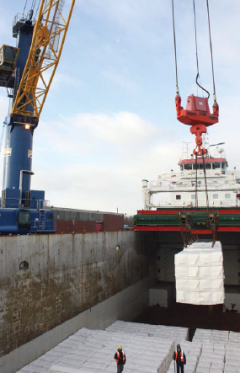Difference between revisions of "Woodpulp"
| Line 1: | Line 1: | ||
| − | {{ | + | {{Infobox_Miscellaneous |
| − | | image = | + | | image = Woodpulp-1.png |
| − | | origin = | + | | origin = |
| − | | stowage factor = | + | | stowage factor = |
| − | | humidity and moisture = | + | | humidity and moisture = |
| − | | ventilation = | + | | ventilation = |
| − | | risk factors = | + | | risk factors = |
}} | }} | ||
==Description== | ==Description== | ||
| Line 11: | Line 11: | ||
<br><br> | <br><br> | ||
Shipped in pressed bales either dry or wet and used for paper products. Bales of woodpulp may distend up to 50% of their volume which can cause bowing of the container.<br><br> | Shipped in pressed bales either dry or wet and used for paper products. Bales of woodpulp may distend up to 50% of their volume which can cause bowing of the container.<br><br> | ||
| − | Stow in a clean dry container and avoid contamination from other cargoes which could result in a loss in value. It is recommended to use dunnage under the bales for drainage and fork-truck handling. After stuffing, the bales must be covered with kraft paper to prevent contamination.<br><br> | + | Stow in a clean dry container and avoid contamination from other cargoes which could result in a loss in value. It is recommended to use [[dunnage]] under the bales for drainage and fork-truck handling. After stuffing, the bales must be covered with kraft paper to prevent contamination.<br><br> |
See IMSBC Code for wood-pulp in bulk.<br><br> | See IMSBC Code for wood-pulp in bulk.<br><br> | ||
<b>Full information on this product is in the process of completion.</b> | <b>Full information on this product is in the process of completion.</b> | ||
Revision as of 16:18, 5 February 2014
| Infobox on Woodpulp | |
|---|---|
| Example of Woodpulp |  |
| Facts | |
| Origin | |
| Stowage factor (in m3/t) | |
| Humidity / moisture | |
| Ventilation | |
| Risk factors | |
Woodpulp
Contents
Description
Vegetable matter reduced to pulp.
Shipped in pressed bales either dry or wet and used for paper products. Bales of woodpulp may distend up to 50% of their volume which can cause bowing of the container.
Stow in a clean dry container and avoid contamination from other cargoes which could result in a loss in value. It is recommended to use dunnage under the bales for drainage and fork-truck handling. After stuffing, the bales must be covered with kraft paper to prevent contamination.
See IMSBC Code for wood-pulp in bulk.
Full information on this product is in the process of completion.











